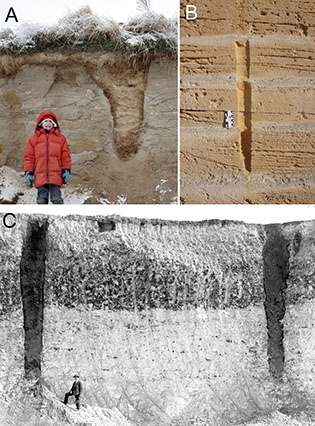A drop hollows out the stone... and records the climate's history
2025-05-29

Water reshapes the Earth through slow, powerful erosion, carving intricate landscapes like caves and pinnacles in soluble rocks such as limestone. An international team from the Faculty of Physics at the University of Warsaw, the University of Florida, and the Institute of Earth Sciences in Orléans has discovered that vertical channels, known as karstic solution pipes, preserve a record of Earth’s climatic history. Their study, published in Physical Review Letters, reveals that these pipes evolve with time into an invariant shape, a fixed, ideal form that remains unchanged as the pipes deepen, encoding ancient rainfall patterns.
Using microfluidic experiments, the team mimicked this process in miniature, etching water into channels within gypsum-lined cells. “We observed something striking,” says Stanisław Żukowski, pursuing PhD at the Faculty of Physics of the University of Warsaw and Université Paris Cité, the first author of the paper. “From a chaotic start, only a few channels survived, each settling into a stable, invariant shape that grew deeper without changing form. This mirrors the behavior of karstic pipes in nature.”
Deriving the mathematical formula for this shape was complex. “Capturing the invariant form required sophisticated mathematical tools, blending fluid dynamics and reactive transport to model how groundwater, driven by rainfall, shapes these pipes,” says Prof. Piotr Szymczak from the Faculty of Physics, University of Warsaw, the corresponding author. “The formula reveals how heavy precipitation accelerates groundwater movement, forming elongated pipes that record in their shape past rainfall conditions.”
Deciphering nature's plan
By studying these shapes, scientists can reconstruct Earth’s climatic past. Understanding these patterns is also crucial for predicting how water moves through underground reservoirs, which has implications for everything from groundwater management to CO₂ storage and even oil recovery.This study is part of a broader effort to understand how simple physical laws give rise to complex natural structures. Just as snowflakes and river deltas follow mathematical rules, so too do the silent, hidden processes of rock dissolution. The discovery of an invariant shape for dissolution fingers is a step toward deciphering nature’s secret blueprint, one drop of water at a time.
This work was supported by the National Science Centre (NCN, Poland) under the CEUS UNISONO grant no. 2020/02/Y/ST3/00121.
Faculty of Physics of the University of Warsaw
Physics and astronomy at the University of Warsaw appeared in 1816 as part of the then Faculty of Philosophy. In 1825, the Astronomical Observatory was established. Currently, the Faculty of Physics at the University of Warsaw consists of the following institutes: Experimental Physics, Theoretical Physics, Geophysics, the Department of Mathematical Methods in Physics, and the Astronomical Observatory. The research covers almost all areas of modern physics on scales from quantum to cosmological. The Faculty's research and teaching staff consists of over 250 academic teachers. About 1,100 students and over 170 doctoral students study at the Faculty of Physics UW. The University of Warsaw is among the 300 best universities in the world, educating in the field of physics according to Shanghai’s Global Ranking of Academic Subjects.
SCIENTIFIC PUBLICATION:
Stanisław Żukowski, Silvana Magni, Florian Osselin, Filip Dutka, Max P. Cooper, Anthony J.C. Ladd, and P. Szymczak, Invariant forms of dissolution fingers, Phys. Rev. Lett., 134, 094101 (2025), DOI: https://doi.org/10.1103/PhysRevLett.134.010405
CONTACT:
Prof. dr hab. Piotr Szymczak
Wydział Fizyki Uniwersytetu Warszawskiego
pa.szymczak@uw.edu.pl
mgr Stanisław Żukowski
Wydział Fizyki Uniwersytetu Warszawskiego
stanisław.zukowski@fuw.edu.pl
RELATED WEBSITES WWW:
https://www.fuw.edu.pl
Website of the Faculty of Physics University of Warsaw
https://www.fuw.edu.pl/informacje-prasowe.html
Press service of the Faculty of Physics at the University of Warsaw
GRAPHIC MATERIALS:
FUW250528b_fig01.jpg
https://www.fuw.edu.pl/tl_files/press/images/2025/FUW250528b_fig01.jpg
Figure 1: Solution pipes from different locations: (A) Smerdyna, Poland (photo by P. Szymczak, University of Warsaw); (B) Guilderton, Australia (photo by P. Szymczak, University of Warsaw); and (C) Swanscombe, England (photo by J. Rhodes, courtesy of the British Geological Survey).
FUW250528b_fig02.jpg
https://www.fuw.edu.pl/tl_files/press/images/2025/FUW250528b_fig02.jpg
Figure 2: Left: Solution pipes in limestone bedrock in Smerdyna quarry, Poland (photo by P. Szymczak, University of Warsaw). Right: dissolution channels formed in a microfluidic experiment. (photo: University of Warsaw).





